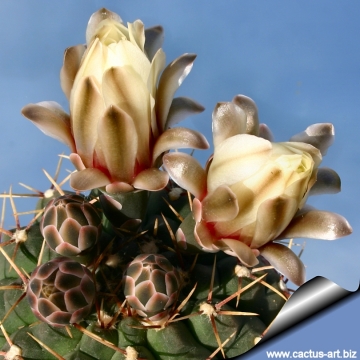Accepted Scientific Name: Gymnocalycium platense (Speg.) Britton & Rose
Cactaceae (Britton & Rose) 3: 163. 1922 [12 Oct 1922] Britton & Rose

Echinocactus gibbosus var. platensis (Gymnocalycium platense) Photo by: Valentino Vallicelli
Origin and Habitat: Argentina (Córdoba and Buenos Aires Province). The original specimens was collected in Prov. Buenos Aires, Ventana, Valle de las Vertientes in 1895 by Spegazzini.
Altitude range: 300-700 metres above sea level.
Habitat and ecology: This plant comes from the arid hills of Pampas (Sierra de la Ventana, Curámalál, Olavarria etc.) mainly in the cracks of the rocks.
Synonyms:
See all synonyms of Gymnocalycium platense
back
Accepted name in llifle Database:Gymnocalycium platense (Speg.) Britton & RoseCactaceae (Britton & Rose) 3: 163. 1922 [12 Oct 1922]Synonymy: 9
back
Description: Gymnocalycium platense is a small, usually unbranched, cactus species, depressed, half-hidden in the earth. It will flower when 3-5 cm in diameter. The flowers with long floral tube, open wide in sunlight, and are commonly white with a reddish reddish throat and a hint of dark shading at the tips of the tepals. This is a delightful plant and well worth growing.
Stem: Solitary, flattened globose to globose, green, dull bluish green, olive green, or purple or bronzed never greyish (rather variable in colour in cultivation depending on growing conditions), 8-10 cm high, 4-10 cm in width.
Ribs: 8-18, usually 13, broad and low, with strong cross-furrows, with distinct rounded tubercles. Tubercles with a horizontal or ascending chin-like projection.
Areoles: Deep-set, when young white-felted.
Radial spines: 3 to 7, thin, needle-like, subulate, rigid, more or less flattened against the stem surface, base swollen pale brown-red, greyish-purple, grey or blackish, with whitish tips, 5-15 mm long.
Central spines: Usually absent.
Flowers: Several together on the crown, diurnal, scentless, 3 to 6.5 cm in length and 4-6.5 cm across, openong wide in sunlight. Tube and ovary dull bluish green bearing a few broad, short, rounded scales, these more or less purplish on the edge. Outer perianth-segments white with a broad green or pinkish stripe down the center. Inner perianth segments pure white with a hint of dark shading at the tips of the tepals. Throat broad, white, reddish or purple within. Filaments numerous, scattered over the throat. Style short and thick, 2 cm long, stigma-lobes cream-coloured. Ovary oblong.
Blooming season: This plant blooms in early summer when it is only 3-4 cm.
Fruits: The ripened ovary is pink, almost spherical, 1-2.5 cm long, 1-2 cm in width, and dehisces (splits) down its length.
Seeds: 1.2-1.2 mm, matt black.
Remarks: Gymnocalycium platense is often confused commercially with unrelated species of the Gymnocalycium bodenbenderianumSN|14405]]SN|14405]] group and Gymnocalycium leptacanthum. Plants sold under this name but having flowers with red throat and glossy brown seeds are probably Gymnocalycium quelianum or a related species.
Subspecies, varieties, forms and cultivars of plants belonging to the Gymnocalycium platense group
 Gymnocalycium platense (Speg.) Britton & Rose: stem usually unbranched, depressed. Flowers with long tube, white with a reddish throat. Radial spines 3 to 7, centrals usually absent. Distribution: Córdoba and Buenos Aires Province.
Gymnocalycium platense (Speg.) Britton & Rose: stem usually unbranched, depressed. Flowers with long tube, white with a reddish throat. Radial spines 3 to 7, centrals usually absent. Distribution: Córdoba and Buenos Aires Province. Gymnocalycium platense var. ventanicola (Speg.) R.Kiesling: has more spines: 9-14 radials, and 1-5 centrals, about 2.5 cm long on mature plants. Higher parts of the Sierra de la Ventana, Buenos Aires.
Gymnocalycium platense var. ventanicola (Speg.) R.Kiesling: has more spines: 9-14 radials, and 1-5 centrals, about 2.5 cm long on mature plants. Higher parts of the Sierra de la Ventana, Buenos Aires.
Bibliography: Major references and further lectures
1) Edward Anderson “The Cactus family” Timber Press, Incorporated, 2001
2) James Cullen, Sabina G. Knees, H. Suzanne Cubey "The European Garden Flora Flowering Plants: A Manual for the Identification of Plants Cultivated in Europe, Both Out-of-Doors and Under Glass" Cambridge University Press, 11/Aug/2011
3) David R Hunt; Nigel P Taylor; Graham Charles; International Cactaceae Systematics Group. "The New Cactus Lexicon" dh books, 2006
4) N. L. Britton, J. N. Rose “The Cactaceae. Descriptions and Illustrations of Plants of the Cactus Family.” Volume 4, The Carnegie Institution of Washington, Washington 1923
5) Curt Backeberg “Die Cactaceae: Handbuch der Kakteenkunde” Gustav Fischer Verlag, Stuttgart New York 1982–1985
 Echinocactus gibbosus var. platensis (Gymnocalycium platense) Photo by: Valentino Vallicelli
Echinocactus gibbosus var. platensis (Gymnocalycium platense) Photo by: Valentino Vallicelli Echinocactus gibbosus var. platensis (Gymnocalycium platense) Photo by: Valentino Vallicelli
Echinocactus gibbosus var. platensis (Gymnocalycium platense) Photo by: Valentino Vallicelli Echinocactus gibbosus var. platensis (Gymnocalycium platense) Photo by: Valentino Vallicelli
Echinocactus gibbosus var. platensis (Gymnocalycium platense) Photo by: Valentino Vallicelli Echinocactus gibbosus var. platensis (Gymnocalycium platense) Photo by: Cactus Art
Echinocactus gibbosus var. platensis (Gymnocalycium platense) Photo by: Cactus Art Echinocactus gibbosus var. platensis (Gymnocalycium platense) Photo by: Cactus Art
Echinocactus gibbosus var. platensis (Gymnocalycium platense) Photo by: Cactus Art Echinocactus gibbosus var. platensis (Gymnocalycium platense) Photo by: Cactus Art
Echinocactus gibbosus var. platensis (Gymnocalycium platense) Photo by: Cactus Art Echinocactus gibbosus var. platensis (Gymnocalycium platense) Photo by: Valentino Vallicelli
Echinocactus gibbosus var. platensis (Gymnocalycium platense) Photo by: Valentino Vallicelli Echinocactus gibbosus var. platensis (Gymnocalycium platense) Photo by: Cactus Art
Echinocactus gibbosus var. platensis (Gymnocalycium platense) Photo by: Cactus ArtCultivation and Propagation: Gymnocalycium platenseSN|21427]]SN|21427]] is very easy to grow, these plants offer no cultivation difficulties.
Watering Needs: Moderate to copious in summer, keep dry in winter.
Frost Tolerance: Quite frost resistant if kept dry -10° C (Temperature Zone: USDA 8-10 )
Cultural Practices: Feed with a high potassium fertilizer in summer.
Sun Exposure: Full sun to light shade
Propagation: Seeds (seldom produces offsets)
Your Photos

by Cactus Art

by Cactus Art

by Valentino Vallicelli

by Valentino Vallicelli























